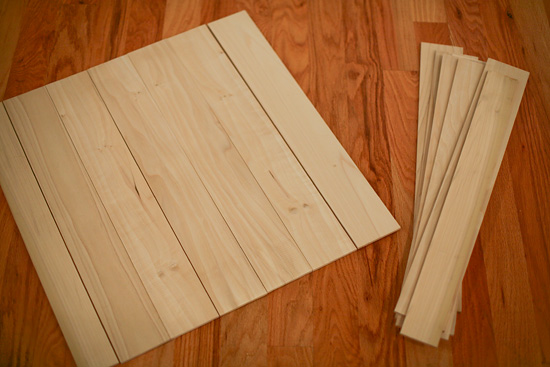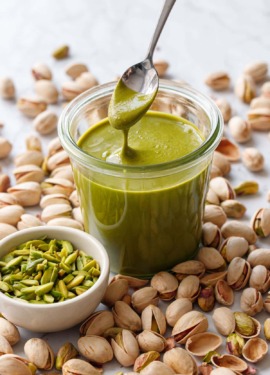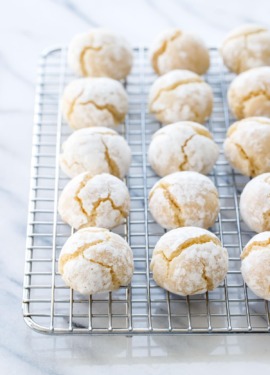
I love using texture in my photos. Whether it be a rough burlap fabric or a distressed piece of wood, it adds so much depth and character to an image. And for those of us who aren’t blessed with a beautiful rustic wood tabletop, we have to resort to drastic measures.
Or not so drastic ones.
My first attempt at a distressed wood background involved getting a long piece of beadboard cut into 2′ lengths, gluing them together, and then painting it white. It worked, but I didn’t love the double grooves of the beadboard. They were too strong and took away focus from the subject. I wanted something a bit more subtle.
On our next trip to the home improvement store, I scoped out some better materials. Lucky for us we went to a different store than our regular one, and there I found some “Pine Board Scants” or “Craft Boards” (signs were conflicting – I don’t know what they were actually called). Basically, it is a 3 1/2″ wide board like normal lumber, but it is only 1/4″ thick. And since my puny little arms are going to have to lift this thing on a regular basis, thinner boards were exactly what I was looking for. They had a variety of different widths, so you could get wider or thinner boards based on your preference. I found these particular boards at Lowes. Home Depot (at least the one we usually go to) didn’t have anything comparable.
This same process can definitely be done with standard 3/4″ thick wood, but your final product will be a lot more bulky, especially if you do the double layer for a reversible background.

For this specific background you will need twelve 3.5″ wide, 2′ long boards, plus two 2.5″ wide boards to make a perfect square. Arrange half of the boards in one direction, and tape in place. I wanted a very small but still distinguishable gap between the boards, the tape helped keep it in place while I glued.

Next, lay the other half of the boards in the opposite direction, gluing in place with wood glue, carefully positioning boards so the gaps are to your liking. Careful not to put too much glue, you don’t want it to ooze through the gabs (or, er, glue it to your floor…)
When the boards are glued in place, put a flat, heavy weight (like an upside down coffee table or a whole lot of books) on top and let dry overnight. You could also use wood clamps if you have them, but basically you just want something that will hold the pieces firmly together until the glue is dry.

Now it’s ready to paint!
For my paint, I simply picked up a few sample containers of paint. $2/a piece, and more than enough paint to cover my little 2×2′ background. One sort of a medium greenish brown color (called Truffle), white, and then two shades of turquoise. My plan was to make use of both sides of the board, have one painted basic white, and the other a pretty bright turquoise.

I wanted the wood to look old, not new. Old wood is dark, and I wanted some of that darkness to show through.
Start by watering down your brown paint. I used probably 50/50 water to paint. But I suggest (and this is what I did) testing your finishes first. I started with the end board, since I knew it wouldn’t show too much in the photographs, and then when I was happy with that finish I repeated the same process for the rest of the board.
Water down your paint, and then brush a coat onto each board, one a time. You want full coverage with this layer. Then take a cloth or paper towel and, while the paint is still wet, wipe it off. This will make the paint act more like a stain than a paint. You can see that the overall color is darker, but the wood grain still shows through. Let this layer dry completely before continuing (or if you’re impatient like me, grab the hair dryer).

Next, time for color. I decided to use two shades of turquoise for added depth. I started with the darker one. Using a fairly dry brush, lightly brush on the color. You don’t want a ton of paint on your brush; spotty coverage and missed spots are good. Brush strokes are good. Rough is good. Move quickly, and don’t overthink it. You can always add more paint, but you can’t take it off. Again, let this layer dry completely.

You can then add the second shade if you have one. I used a lighter turquoise, and you can see the difference between the 1st coat and the second. Similar technique, again, you don’t want a solid coat, you want some of that dark brown wood and the darker turquoise underneath to show through.
When all was done and dry, my board had a bit too much sheen to it (samples only came in satin, not eggshell or flat). Easy fix, I just took some fine grain sandpaper to it to dull and further roughen the finish. You can see the final result in the kumquat picture above.

Initially, the plan was to repeat the same process on the back but paint it white. But I was kind of digging the dark stain all by itself, and decided to leave it that way… at least for now. Who knows, I may come back later and continue with the white. Or I may just make a second one altogether.
And there you have it! For about $40, you have a portable, reversible wood backdrop for your photos! Spiffy!
(On a related note, for those of you interested in food photography, you must must MUST check out the new book, Plate to Pixel, by Helene Dujardin of Tartelette. I was lucky enough to meet Helene last month in Orlando, and she is as lovely in person as she seems on her blog. Plate to Pixel is full of uber-helpful information, whether you are just starting out with food photography or already comfortable behind the lens. Do it!)










I can not unsee that face!!!
This is a great help. Thanks so much. Checking out the plate to pixel blog now
Thank you Lindsay! I just finished my brand new swanky background today, and cannot wait to use it!
You are my hero! I was wondering how to make a double-sided board. This is going to be my weekend project!
Thank you for this tutorial!! I will definately use it! I just have one question. Can I place some fruits (or other food) on the board as I suppose these colors are toxic? Or did you use a special non-toxic ones?
i love this idea. Did you only tape the bottom boards together & then glue the top pieces to them?
Thank you for your creativity & inspiration.
Just wanted to let you know that I’ve had my eye on this tutorial for ages, but I finally pulled the trigger on it this weekend! I just started my own blog after dabbling in food photography for a while and I needed some more inspiration for photos. I made 2 double sided boards, so now I’ve got brown, white, blue, and red to choose from. Thanks for the great instructions!
Thank you! (Great big sigh of relief!) After not being able to find a good resource for wood background props I decided to DIY it
and so glad I found your post! This is exactly what I needed. Your board came out great.
Thanks a million <3
I have been looking for a technique like this on youtube for a while and I ran across yours by accident. I bought the same the exact same board at Lowes and my finished product was awesome. I am using the board on one wall of a beach cottage and I know it is going to look amazing. wish I could add a photo to show you how good my results were. thanks again.
I’ve been struggling with finding good backdrops for months now. I have two staples, but dying for more. Love this DIY tutorial, there’s a trip to Home Depot in my future!
Lovely ideas and thanks for wonderful tips !! I’m going to try this for a new background for my food photography.
http://www.malas-kitchen.com
– Thanks
I am so glad I found this post. I used your tutorial as the guide for making my own food photography board. I did dark wood as one side and grey as the other. I love how they turned out. Now, I am about to rip apart free pallets and make some boards out of those. Thank you so much for sharing this.
If you would like to see how my board turned out (I did credit you for the idea!): http://yumeating.com/diy-distressed-wood-photography-prop/
I love that you made it reversible! What a clever idea! I just made my first wooden backdrop to add texture to my photos… Here is my step by step picture tutorial: http://www.recipris.com/2014/01/01/diy-white-wood-photo-backdrop/
I’m definitely going to try making another one though… I really like the simple stained board you created on the other side of the blue! Looks just like a picnic table :)
Wow – your DIY helped me out the most! Thank for explaining the paint color and the plank backing.
This is exactly what I was looking for! I’m doing this over the weekend! Thanks for the tutorial!
I think in order to achieve similar results as in this tutorial. You need to be really experienced craftsman. I’ve tried it look bad.
Thanks! I enjoyed the DIY. I’ve got a granite countertop and it’s hard to get get good shots because of all the shine.
Thanks for this tutorial! Found it through Pinch of Yum’s Tasty Food Photography e-book. I look forward to creating several of these for future projects!
This is great content. I struggle with food photography and just recently realized I need to make it easier for myself and get some props and backgrounds done and ready to go when I am ready to take photos. This will save me a lot of time. Thanks for sharing.
Wow,
I have been driving DH nuts about how to figure this one out! ANd your post came just in time..I am sick of my counter top and I ve been drooling at rustic wooden tables particularly in the color you`ve showcased.. COuld you please add the name/number of the paints that u bot from Lowes. We have never painted and I need to start from scratch. IAlso what is that glue?
Thanks
Shobha
What are the paint color names?
Love that brown stain effect! What brand of paint is it? You said it’s called “Truffle”? Thanks!
I took this tutorial, made a red one and used it for my photos, THEN we were setting the table for Thanksgiving and my friend saw it and grabbed it for the base under the certerpiece. I LOVE it, I’m making more. Thank you
What is the color name/brand? Looks like a Valspar brand.
what color or name of color for turquoise
Hi thanks for the tutorial. Please could you tell me the name of the fruit that you used in this picture?! Looks delicious!!! Thanks!!
This weekend, I’ll absolutely be doing this. Thanks for a great tutorial!
This is fab! That blue you used is my favorite color. I will be doing this next week!
I love your blog, I love the name, and before I made it here I was a fan because of your website design with Purr. I was so surprised when I found out Purr and this blog were the same folks!
best,
AG
prettybluerose.com
Thanks for this!!! I just made one this weekend and it turned out gorgeous. Loved your instructions for the “stain;” I’d have never thought of that :)
What a great idea – thanks for sharing. I’m going to try this for a new background for my jewellery photos. At the moment I’m using a white unpainted canvas, ut this will take my photo’s up a notch!
Do you have any suggestions on how to do this similar treatment, but on a piece that already has a finish on it? I want to do this to my shelves I picked up at Goodwill, but they already have a finish on them. Is there a way to do it short of sanding the whole thing down?
Hello,
Starting on this project, and I found wood flooring that was about 3ft and 1/4 thick that has those lines, but also grooves so it clicks together. About $11 for a pack and all you have to do is use the wood glue in the grove. You don’t have glue another set on top of it! Woo hoo, even thinner, cheaper and more portable. Triple score. Thanks for this great post.
Julie directed me here when I asked on Instagram is someone had blogged this. Thanks for all the helpful tips…I’ve been wanting to do this for a long time. :)
love, love this idea! I’m updating my shop look soon, and can’t wait to use this! I so love that it’ll be small, light and easy to store! Thanks for sharing! :)
Could you share exactly what shades of turquoise you used for the distressed wood, and the brand of paint?
I just tried this over the weekend and it works like a gem! Instead of the brown, I used a black and just watered it down a little more! It looks amazing! Thanks for the awesome tip!
Great idea, thank you for sharing! :) I can’t wait to make mine.
Hi Lindsay,
I followed your guide and made my own wood tabletop…I love it! Thank you sor sharing!
Roberta
I have been wanting to find this post again for ages – but could not remember who’s blog it was on. Just pinned so now I have it forever. Now I need to make more boards :) Thanks!
Thank you so much for posting this. I’m working on my own version today and using a blueish wood stain. We’ll see how it turns out . . .
Brilliant! I love this idea. I’m definitely going to do it myself! Someone also gave me a great idea for backgrounds– get some fabric you like and stretch it across white foam core. You can just tape it with packing tape to the back. Bingo! Lightweight patterned background!
me too, I wanna know the paint colors!!
Just loved this, I’m so into turquoise right now. What are the paint names that you used?
Wow!!!! Loved it! Thanks so much for sharing!
Awesome tutorial. I was wondering how to get the wood distressed look. Your step by step really helped!
I want to learn about Helene’s lighting technique! Wonderful post.